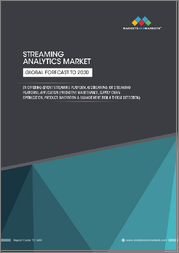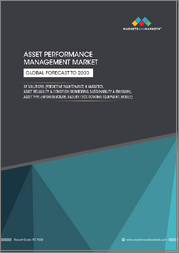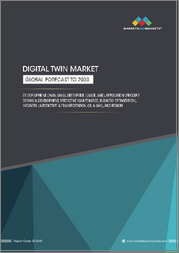
|
시장보고서
상품코드
1609880
일본의 예지보전 시장 보고서 : 컴포넌트, 도입, 최종사용자, 지역별(2025-2033년)Japan Predictive Maintenance Market Report by Component (Solutions, Services), Deployment (On-premise, Cloud), End User (Energy and Utilities, Transportation, Manufacturing, Healthcare, and Others), and Region 2025-2033 |
||||||
일본의 예지보전 시장의 시장 규모는 2024년에 7억 7,470만 달러에 달했습니다. 향후 IMARC Group은 시장이 2033년까지 74억 70만 달러에 달하며, 2025-2033년의 성장률(CAGR)은 28.5%에 달할 것으로 예측하고 있습니다. 이 시장은 머신 투 머신(M2M) 통신의 이용 확대, 노후화한 산업 기기의 가동 수명 연장에 대한 투자 확대, 첨단 검사를 시행하기 위한 원격 감시의 도입 확대 등 몇개의 중요한 요인에 의해 추진되고 있습니다.
본 리포트에서 답변하는 주요 질문
- 일본의 예지보전 시장의 지금까지 실적과 향후 수년간 실적은?
- 일본의 예지보전 시장에 COVID-19가 미친 영향은?
- 일본의 예지보전 시장의 컴포넌트별 내역은?
- 일본의 예지보전 시장의 도입별 내역은?
- 일본의 예지보전 시장의 최종사용자별 내역은?
- 일본의 예지보전 시장의 밸류체인에는 어떤 단계가 있는가?
- 일본의 예지보전에서 주요 촉진요인과 과제는?
- 일본의 예지보전 시장의 구조와 주요 기업은?
- 일본의 예지보전 시장에서 경쟁의 정도는?
목차
제1장 서문
제2장 조사 범위와 조사 방법
- 조사의 목적
- 이해관계자
- 데이터 소스
- 시장 추정
- 조사 방법
제3장 개요
제4장 일본의 예지보전 시장 : 서론
- 개요
- 시장 역학
- 업계 동향
- 경쟁 정보
제5장 일본의 예지보전 시장 구도
- 과거 및 현재 시장 동향(2019-2024년)
- 시장 예측(2025-2033)
제6장 일본의 예지보전 시장 : 컴포넌트별 내역
- 솔루션
- 서비스
제7장 일본의 예지보전 시장 : 도입별 내역
- 온프레미스
- 클라우드
제8장 일본의 예지보전 시장 : 최종사용자별 내역
- 에너지와 유틸리티
- 운송기관
- 제조
- 헬스케어
- 기타
제9장 일본의 예지보전 시장 : 경쟁 구도
- 개요
- 시장 구조
- 시장 기업 포지셔닝
- 주요 성공 전략
- 경쟁 대시보드
- 기업 평가 상한
제10장 주요 기업의 개요
제11장 일본의 예지보전 시장 : 업계 분석
- 촉진요인·억제요인·기회
- Porter's Five Forces 분석
- 밸류체인 분석
제12장 부록
KSA 24.12.26Japan predictive maintenance market size reached USD 774.7 Million in 2024. Looking forward, IMARC Group expects the market to reach USD 7,400.7 Million by 2033, exhibiting a growth rate (CAGR) of 28.5% during 2025-2033. The market is being propelled by several significant factors, including the expanding use of machine-to-machine (M2M) communication, greater investments in prolonging the operational lifespan of aging industrial equipment, and the increased incorporation of remote monitoring for conducting advanced inspections.
Predictive maintenance is a methodology that relies on the use of condition-monitoring tools and systems for real-time equipment performance monitoring. This approach incorporates technologies like the Internet of Things (IoT), artificial intelligence (AI), and integrated systems to connect various assets and share and analyze critical data. It encompasses components such as predictive maintenance sensors, industrial controls, and business software like Enterprise Asset Management (EAM) and Enterprise Resource Planning (ERP) systems. The core function of predictive maintenance is to employ condition monitoring equipment to assess and analyze asset performance. It gathers diverse data points, including temperature, vibrations, and conductivity, enabling engineers to anticipate equipment or asset failures and plan for proactive repairs or replacements. Predictive maintenance offers advantages such as cost reduction, extended equipment lifespan, and enhanced productivity. Furthermore, its demand is on the rise due to its contribution to safety compliance and the ability to take preemptive corrective actions.
Japan Predictive Maintenance Market Trends:
The predictive maintenance market in Japan is experiencing substantial growth, driven by the country's technological prowess and its commitment to optimizing industrial operations. Japanese industries have been quick to adopt predictive maintenance strategies that leverage advanced technologies such as the Internet of Things (IoT), artificial intelligence (AI), and integrated systems. These technologies are used to monitor and analyze critical equipment data in real-time, allowing for the early detection of potential failures or maintenance needs. Japan's extensive manufacturing sector, including automotive and electronics industries, has recognized the value of predictive maintenance in reducing downtime, lowering maintenance costs, and ensuring the efficient operation of machinery and production lines. Additionally, the integration of predictive maintenance with safety compliance measures has made it a crucial component of industrial processes. As Japan continues to prioritize innovation and efficiency in its industrial landscape, the predictive maintenance market is expected to witness further expansion and adoption across various sectors.
Japan Predictive Maintenance Market Segmentation:
Component Insights:
- Solutions
- Services
Deployment Insights:
- On-premise
- Cloud
End User Insights:
- Energy and Utilities
- Transportation
- Manufacturing
- Healthcare
- Others
Competitive Landscape:
The market research report has also provided a comprehensive analysis of the competitive landscape. Competitive analysis such as market structure, key player positioning, top winning strategies, competitive dashboard, and company evaluation quadrant has been covered in the report. Also, detailed profiles of all major companies have been provided.
Key Questions Answered in This Report:
- How has the Japan predictive maintenance market performed so far and how will it perform in the coming years?
- What has been the impact of COVID-19 on the Japan predictive maintenance market?
- What is the breakup of the Japan predictive maintenance market on the basis of component?
- What is the breakup of the Japan predictive maintenance market on the basis of deployment?
- What is the breakup of the Japan predictive maintenance market on the basis of end user?
- What are the various stages in the value chain of the Japan predictive maintenance market?
- What are the key driving factors and challenges in the Japan predictive maintenance?
- What is the structure of the Japan predictive maintenance market and who are the key players?
- What is the degree of competition in the Japan predictive maintenance market?
Table of Contents
1 Preface
2 Scope and Methodology
- 2.1 Objectives of the Study
- 2.2 Stakeholders
- 2.3 Data Sources
- 2.3.1 Primary Sources
- 2.3.2 Secondary Sources
- 2.4 Market Estimation
- 2.4.1 Bottom-Up Approach
- 2.4.2 Top-Down Approach
- 2.5 Forecasting Methodology
3 Executive Summary
4 Japan Predictive Maintenance Market - Introduction
- 4.1 Overview
- 4.2 Market Dynamics
- 4.3 Industry Trends
- 4.4 Competitive Intelligence
5 Japan Predictive Maintenance Market Landscape
- 5.1 Historical and Current Market Trends (2019-2024)
- 5.2 Market Forecast (2025-2033)
6 Japan Predictive Maintenance Market - Breakup by Component
- 6.1 Solutions
- 6.1.1 Overview
- 6.1.2 Historical and Current Market Trends (2019-2024)
- 6.1.3 Market Forecast (2025-2033)
- 6.2 Services
- 6.2.1 Overview
- 6.2.2 Historical and Current Market Trends (2019-2024)
- 6.2.3 Market Forecast (2025-2033)
7 Japan Predictive Maintenance Market - Breakup by Deployment
- 7.1 On-premise
- 7.1.1 Overview
- 7.1.2 Historical and Current Market Trends (2019-2024)
- 7.1.3 Market Forecast (2025-2033)
- 7.2 Cloud
- 7.2.1 Overview
- 7.2.2 Historical and Current Market Trends (2019-2024)
- 7.2.3 Market Forecast (2025-2033)
8 Japan Predictive Maintenance Market - Breakup by End User
- 8.1 Energy and Utilities
- 8.1.1 Overview
- 8.1.2 Historical and Current Market Trends (2019-2024)
- 8.1.3 Market Forecast (2025-2033)
- 8.2 Transportation
- 8.2.1 Overview
- 8.2.2 Historical and Current Market Trends (2019-2024)
- 8.2.3 Market Forecast (2025-2033)
- 8.3 Manufacturing
- 8.3.1 Overview
- 8.3.2 Historical and Current Market Trends (2019-2024)
- 8.3.3 Market Forecast (2025-2033)
- 8.4 Healthcare
- 8.4.1 Overview
- 8.4.2 Historical and Current Market Trends (2019-2024)
- 8.4.3 Market Forecast (2025-2033)
- 8.5 Others
- 8.5.1 Historical and Current Market Trends (2019-2024)
- 8.5.2 Market Forecast (2025-2033)
9 Japan Predictive Maintenance Market - Competitive Landscape
- 9.1 Overview
- 9.2 Market Structure
- 9.3 Market Player Positioning
- 9.4 Top Winning Strategies
- 9.5 Competitive Dashboard
- 9.6 Company Evaluation Quadrant
10 Profiles of Key Players
- 10.1 Company A
- 10.1.1 Business Overview
- 10.1.2 Product Portfolio
- 10.1.3 Business Strategies
- 10.1.4 SWOT Analysis
- 10.1.5 Major News and Events
- 10.2 Company B
- 10.2.1 Business Overview
- 10.2.2 Product Portfolio
- 10.2.3 Business Strategies
- 10.2.4 SWOT Analysis
- 10.2.5 Major News and Events
- 10.3 Company C
- 10.3.1 Business Overview
- 10.3.2 Product Portfolio
- 10.3.3 Business Strategies
- 10.3.4 SWOT Analysis
- 10.3.5 Major News and Events
- 10.4 Company D
- 10.4.1 Business Overview
- 10.4.2 Product Portfolio
- 10.4.3 Business Strategies
- 10.4.4 SWOT Analysis
- 10.4.5 Major News and Events
- 10.5 Company E
- 10.5.1 Business Overview
- 10.5.2 Product Portfolio
- 10.5.3 Business Strategies
- 10.5.4 SWOT Analysis
- 10.5.5 Major News and Events
11 Japan Predictive Maintenance Market - Industry Analysis
- 11.1 Drivers, Restraints, and Opportunities
- 11.1.1 Overview
- 11.1.2 Drivers
- 11.1.3 Restraints
- 11.1.4 Opportunities
- 11.2 Porters Five Forces Analysis
- 11.2.1 Overview
- 11.2.2 Bargaining Power of Buyers
- 11.2.3 Bargaining Power of Suppliers
- 11.2.4 Degree of Competition
- 11.2.5 Threat of New Entrants
- 11.2.6 Threat of Substitutes
- 11.3 Value Chain Analysis



















